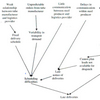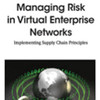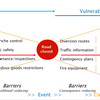 Global supply chains are increasingly becoming more vulnerable to potential disruption to trade, says Aon, one of the world’s leading providers of risk management services, insurance and reinsurance brokerage. Every year, Aon publishes a political risk map, and in 2009 the number of countries tagged with ‘supply chain vulnerability’ has increased from 38 to 54 due to risks ranging from government embargo or interference with a supplier through to strikes, terrorism and sabotage.
Global supply chains are increasingly becoming more vulnerable to potential disruption to trade, says Aon, one of the world’s leading providers of risk management services, insurance and reinsurance brokerage. Every year, Aon publishes a political risk map, and in 2009 the number of countries tagged with ‘supply chain vulnerability’ has increased from 38 to 54 due to risks ranging from government embargo or interference with a supplier through to strikes, terrorism and sabotage.
The commodity crunch
This year’s map includes a Commodity Crunch Exposure Matrix, which identifies the countries most vulnerable to political instability in 2009 if commodity prices continue to fall, as has been suggested by some forecasters. According to Roger Schwartz, senior vice president of Aon Trade Credit,
Volatility in global commodity prices contributed to political and economic instability in a number of countries in the 1970s and early 1980s. Countries that until recently benefited from very high commodity prices may now suffer as they fall. The types of commodities we are talking about include oils, metals and minerals.
Interestingly, Norway makes an entrance on this list, with a medium to medium-high risk. Should I be worried?
Understand – Identify – Mitigate
According to Alex Hindson, head of enterprise risk management at Aon Global Risk Consulting, the key to managing supply chain risk is to gain an understanding of the risks.:
Mapping key supplier dependencies is the first step in taking control of the risk exposures. By identifying single point failures and quantifying exposures, organisations can take conscious decisions to mitigate exposures. Mitigation might include multiple sourcing, safety stock holding, consignment stock or business continuity plans based on rerouting manufacturing through alternative manufacturing facilities. As always plans needs to be put in place and tested prior to the event to be any guarantee of supply chain resilience.
Downloads
- aon risk map : Aon Political Risk Map
Global Risks
In 2008, the World Economic Forum published a report on Global Risks 2008 that highlighted the risk potential that global supply chains have, and the report on Global Risks 2009 even put whole countries at risk.
Related
- husdal.com: Global Risks 2009
- husdal.com: Global Risks 2008












